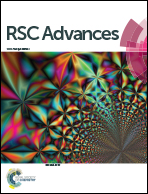Preparation of poly(styrenesulfonic acid) grafted Nafion with a Nafion-initiated atom transfer radical polymerization for proton exchange membranes
Abstract
This work reports the synthesis of a poly(styrenesulfonic acid)-grafted Nafion (Nafion-g-PSSA) copolymer through atom transfer radical polymerization (ATRP) using Nafion chains as a macroinitiator. The C–F linkages of the –CF– groups and –CF2–SO3H groups serve as the initiating sites for the ATRP of the employed styrenic monomer. The PSSA chains further enhance the hydrophilic–hydrophobic microphase separation in the Nafion-g-PSSA based membrane, demonstrating relatively large ionic cluster domains and small distances between the hydrophilic and hydrophobic domains compared to the neat Nafion based membrane. Consequently, Nafion-g-PSSA is an effective additive for the fabrication of Nafion-based proton exchange membranes. With an optimum fraction of 15 wt% Nafion-g-PSSA, the modified Nafion membrane exhibits a proton conductivity of about 97 mS cm−1 (95 °C, RH = 100%), which is larger than the values measured on the recast neat Nafion membrane (53 mS cm−1) and a commercial Nafion 212 membrane (88 mS cm−1). The Nafion-initiated ATRP is effective for preparation of Nafion derivative materials for proton exchange membranes.



 Please wait while we load your content...
Please wait while we load your content...